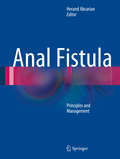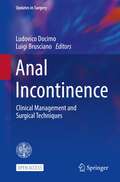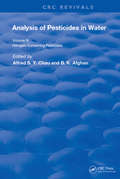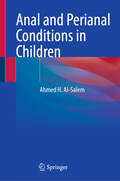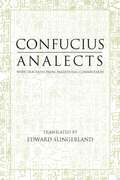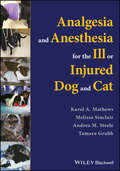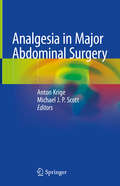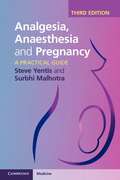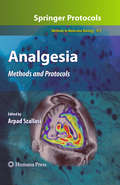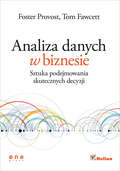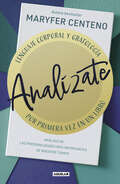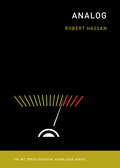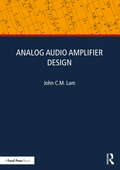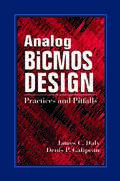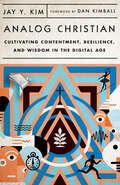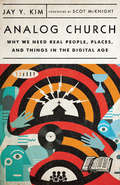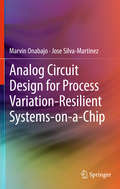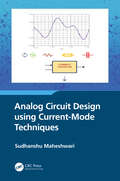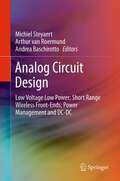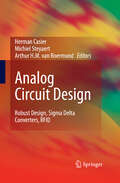- Table View
- List View
Anal Fistula and Abscess (Coloproctology)
by Carlo Ratto Angelo Parello Francesco Litta Veronica De Simone Paola CampennìThis volume comprehensively describes the anatomy, pathophysiology, diagnostics, and modalities of treatment of one of the most complex and debated clinical conditions in coloproctology: anal fistulas and abscesses. It also debates current controversies and presents the best approaches based on the authors’ clinical expertise. Providing an in-depth understanding of the anal canal anatomy and surrounding area, it enables readers to manage anal sepsis and avoid excessive damage, in particular to the anal sphincters. Further, the book presents insights into the pathophysiological processes (in cryptoglandular and Crohn’s disease) causing abscess and fistula, which have a significant impact on the management of these conditions. It also discusses diagnostic assessments crucial for selecting the optimal surgical technique and offers guidance on the timing. Lastly, it assesses the pros and contras of the various surgical procedures, evaluating the possible outcome in terms of both therapeutic success and detrimental effects on the anorectal functions. As such it is a valuable resource for all physicians involved in the management of anal fistulas and abscesses (coloproctologists, general surgeons, gastroenterologists, radiologists).
Anal Fistula: Principles and Management
by Herand AbcarianAnal Fistula: Principles and Management provides a comprehensive and state of the art review of major issues specific and related to the treatment of anal fistulas. An important section of the book covers the large number of alternative procedures which have been developed in the last two decades. Needless to say, none of these procedures have been uniformly successful, otherwise there would be no need for all the different operations. The book addresses each alternative procedure, discusses the benefits of each procedure, includes the most up-to-date results. Other important chapters cover the causes and failure of treatment and operations for fistulas. Also included is a Cochrane Review of all available randomized controlled trials with levels of evidence culled from the literature. Written by specialists in their respective fields, Anal Fistula: Principles and Management fills a void in available texts on a subject matter very commonly encountered by surgeons, physicians and specialists.
Anal Incontinence: Clinical Management and Surgical Techniques (Updates in Surgery)
by Ludovico Docimo Luigi BruscianoThis open access book describes the latest advances in the anal incontinence diagnostic and therapeutic processes. Anal incontinence is a devastating condition heavily impacting on the patients’ lives. Those suffering from this disorder are generally very embarrassed and reluctant to undergo an appropriate clinical evaluation, thus becoming more isolated and worsening the quality of their life. Luckily, nowadays a wide range of treatments is available to improve this oppressive condition; however, the recognition of the related pathophysiological alterations is mandatory to grant its successful management. This volume will help the surgeons community to keep abreast of developments in diagnostics and treatment of this impairing condition. and will provide all health professionals with the appropriate tools to face this impairing condition.
Anal Of Pest In Water Anal Nitrogen Cont Pest (Routledge Revivals #3)
by B. K. Afghan Alfred S.Y. ChauFirst Published in 1982, this set offers a comprehensive guide into the process of analysing water for pesticides. Carefully compiled and filled with a vast repertoire of notes, diagrams, and references this book serves as a useful reference for students of toxicology and other practitioners in their respective fields.
Anal and Perianal Conditions in Children
by Ahmed H. Al-SalemPediatric Surgery is rapidly growing, and there is a need for specialized books that cover specific topics in greater detail. This book is based on Dr Al-Salem’s extensive experience in pediatric surgery, with an emphasis on etiology, clinical features, diagnosis, and management. It is written in a straightforward, easy to read, and well-illustrated manner. The book focuses on anal and perianal conditions in children and serves as a useful and quick reference for pediatric surgeons, pediatricians, general surgeons, family physicians, emergency room physicians, fellows, residents, nurses, and students. Anal and perianal diseases are not rare in children and can cause significant discomfort, pain, disability, and disruption to the daily routine of both the child and their family. These conditions include both congenital and acquired diseases, such as anal fissures, rectal prolapse, hemorrhoids, perianal abscesses, and fistulas. Other disorders include sacrococcygeal teratoma, anorectal malformations, and anterior ectopic anus. Additionally, perianal dermatitis, which can be allergic, bacterial, fungal, diaper-related, or contact-induced, is a common inflammatory condition affecting infants and children. While anal and perianal diseases in children are usually benign, it is crucial to diagnose and treat them early to exclude more serious conditions, including inflammatory bowel diseases. Diagnosis relies on a thorough medical history, careful physical examination, and, rarely, endoscopy and radiology. Management includes both medical and surgical options, and with early diagnosis and treatment, the prognosis is excellent.
Anal and Rectal Diseases: A Concise Manual (Remedica Explained S. Ser.)
by Mark Singer Eli D. Ehrenpreis Shmuel AvitalAnal and Rectal Diseases: A Concise Manual provides a succinct reference on the subject for clinicians, including primary care physicians, gastroenterologists, general surgeons, physician's assistants and nurse practitioners. Presented in a consistent structural style that provides both a general summary of individual topics within the field along with additional details to assist those with some background knowledge in the subject area, this handy volume provides information related to the field of anorectal disease in a format that is easily accessible for rapid acquisition of knowledge. Each topic is outlined in a multidisciplinary fashion with the medical, surgical, and pathological aspects clearly detailed in each section. Each section clearly describes the condition with up-to-date management guidelines and precious clinical pearls. The volume features high quality illustrations in the form of elegant hand drawn figures, tables, photographs of physical findings, endoscopic finds and radiographs. The clinical photographs and x-rays will be of great value to gastroenterologists whose specialty is not coloproctology. Chapters on computerized tomographic colography (virtual colonoscopy) and others cover the newer technologies employed for diagnostic purposes in these diseases. Anal and Rectal Diseases: A Concise Manual provides clinicians with a tool for rapid consultation for direct patient care and management.
Analects
by David HintonWhile Confucius failed in his lifetime to rescue a crumbling civilization with his teachings, he was to become the most influential sage in human history. His thought, still remarkably current and even innovative after 2500 years, survives here in The Analects - a collection of brief aphoristic sayings that has had a deeper impact on more people's lives over a longer period of time than any other book in human history.Formulated in the ruins of a society that had been founded on untenable spiritualistic concepts of governance, Confucius' philosophy postulated a humanistic social order that has survived as China's social ideal ever since. Beginning with the realization that society is a structure of human relationships, Confucius saw that in a healthy society this structure must be a selfless weave of caring relationships. Those caring relationships are a system of "ritual" that people enact in their daily lives, thus infusing the secular with scared dimensions.Highly regarded for the poetic fluency he brings to his award-winning work, David Hinton is the first twentieth-century translator to render the four central masterworks of ancient Chinese thought: Chuang Tzu, Mencius, The Analects, and Tao te Ching (forthcoming). HIs new versions are not only inviting and immensely readable, but they also apply a much-needed consistency to key terms in these texts, lending structural links and philosophical rigor heretofore unavailable in English. Breathing new life into these originary classics, Hinton's translations will stand as the definitive series for our era.
Analects: With Selections from Traditional Commentaries (Hackett Classics)
by ConfuciusThis edition goes beyond others that largely leave readers to their own devices in understanding this cryptic work, by providing an entrée into the text that parallels the traditional Chinese way of approaching it: alongside Slingerland's exquisite rendering of the work are his translations of a selection of classic Chinese commentaries that shed light on difficult passages, provide historical and cultural context, and invite the reader to ponder a range of interpretations. The ideal student edition, this volume also includes a general introduction, notes, multiple appendices--including a glossary of technical terms, references to modern Western scholarship that point the way for further study, and an annotated bibliography.
Analgesia and Anesthesia for the Ill or Injured Dog and Cat
by Karol A. Mathews Melissa Sinclair Andrea M. Steele Tamara GrubbAnalgesia and Anesthesia for the Ill or Injured Dog and Cat provides a comprehensive guide to anesthesia and pain management protocols, specifically tailored to ill or critically injured dogs and cats. Provides fast access to anesthesia and pain management protocols specifically tailored to ill or critically injured dogs and cats Takes a case-based structure to make it easy to find and apply relevant information Presents step-by-step clinical procedures and techniques Supplies concise, relevant background information for all drugs recommended in the protocols, highlighting recommendations and cautions for specific patient conditions Includes detailed information for geriatric, pregnant, nursing, and pediatric patients and those with cardiac, liver or kidney pathology
Analgesia in Major Abdominal Surgery
by Anton Krige Michael J. ScottThis book presents current evidence in an Enhanced Recovery Programme context, and provides a common sense approach to using the array of available analgesia techniques appropriately in major abdominal surgery. Current pain relief options are discussed, many of which have been described only in the last ten years. Topics covered range from the now widespread use of portable ultrasound machines to an appreciation of the value of some older drugs in a new context. Analgesia for Major Abdominal Surgery is aimed at anesthetists, acute pain teams, and acute pain nurses, as well as colorectal, hepatobiliary, urological and gynecological surgeons.
Analgesia, Anaesthesia and Pregnancy
by Steve Yentis Surbhi MalhotraAnalgesia, Anaesthesia and Pregnancy focuses on pre-empting problems and maximising quality of care. Every chapter of this well-established practical guide has been completely updated and revised. All aspects of obstetric medicine relevant to the anaesthetist are covered, from pre-pregnancy management to conception, throughout pregnancy, to postnatal care. The authors have identified over 150 potential complications, each covered in two parts: 'problems/special considerations' and 'management options', with key points prominently displayed for quick reference. A section on organisational aspects such as record keeping, training protocols and guidelines makes this an important resource for any labour ward or hospital dealing with pregnant women. Presented in a clear, structured format, this practical summary will be invaluable to any anaesthetist encountering obstetric patients, whether they are a practiced consultant or still in training. It will also be useful for obstetricians, neonatologists, midwives, nurses and operating department practitioners wishing to extend or update their knowledge.
Analgesia, Anaesthesia and Pregnancy: A Practical Guide
by Steve Yentis Surbhi Malhotra Róisín Monteiro Marwa SalmanNow in its fourth edition, Analgesia, Anaesthesia and Pregnancy is a concise guide to obstetric anaesthesia and analgesia. This essential text reviews every topic and clinical challenge faced during delivery and focuses on pre-empting problems and maximising quality of care. It also covers acute emergencies related to pregnancy. This new edition features 11 new chapters that cover the significant updates in the field over the last few years. Presented in a clearly structured format, this practical guide will be an invaluable source of key information for any anaesthetist encountering obstetric patients, whether they are a practised consultant or still in training. Obstetricians, neonatologists, midwives, nurses, and anaesthetic assistants in obstetric analgesia and anaesthesia who wish to extend or update their knowledge will also benefit from reading this book.
Analgesia: Methods and Protocols (Methods in Molecular Biology #617)
by Arpad SzallasiChronic pain is a complex phenomenon, which continues to remain undertreated in the majority of affected patients thus representing a significant unmet medical need, but the development of cellular, subcellular, and molecular methods of approaching this epidemic of pain shows great promise. In Analgesia: Methods and Protocols, experts in the field present thorough coverage of molecular analgesia research methods from target discovery through target validation and clinical testing to tolerance and dependence, with extensive chapters on emerging receptor classes as targets for analgesic drugs and innovative analgesic strategies. As a volume in the highly successful Methods in Molecular BiologyTM series, the chapters include introductions to their respective topics, lists of the necessary materials and reagents, step-by-step, readily reproducible protocols, and notes sections with tips on troubleshooting and avoiding known pitfalls. Comprehensive and essential, Analgesia: Methods and Protocols promises to aid and enrich the research of all those scientists and clinicians who are interested in what the increasingly molecular future has in store for analgesia research, from the molecular research bench through the animal laboratory to the bedside.
Analiza danych w biznesie. Sztuka podejmowania skutecznych decyzji
by Tom Fawcett Foster ProvostWszystko co powiniene? wiedzie? o eksploracji danych i my?leniu w kategoriach analityki danych. Wyci?gaj trafne wnioski! „Lektura obowi?zkowa dla ka?dego, kto powa?nie my?li o wykorzystaniu okazji, jakie nios? ze sob? wielkie zbiory danych”.— Craig Vaughan, globalny wiceprezes SAPPosiadanie zbiorów danych to po?owa sukcesu. Druga po?owa to umiej?tno?? ich skutecznej analizy i wyci?gania wniosków. Dopiero na tej podstawie b?dziesz w stanie w?a?ciwie oceni? kondycj? Twojej firmy oraz podj?? s?uszne decyzje. Wiedza zawarta w tej ksi??ce mo?e zadecydowa? o sukcesie biznesowym lub pora?ce. Nie ryzykuj i si?gnij po to doskona?e ?ród?o wiedzy, po?wi?cone nauce o danych.To unikalny podr?cznik, który pomo?e Ci sprawnie opanowa? nawet najtrudniejsze zagadnienia zwi?zane z analiz? danych. Dowiedz si?, jak zbudowany jest proces eksploracji danych, z jakich narz?dzi mo?esz skorzysta? oraz jak stworzy? model predykcyjny i dopasowa? go do danych. W kolejnych rozdzia?ach przeczytasz o tym, czym grozi nadmierne dopasowanie modelu i jak go unika? oraz jak wyci?ga? wnioski metod? najbli?szych s?siadów. Na koniec zaznajomisz si? z mo?liwo?ciami wizualizacji skuteczno?ci modelu oraz odkryjesz zwi?zek pomi?dzy nauk? o danych a strategi? biznesow?. To obowi?zkowa lektura dla wszystkich osób chc?cych podejmowa? ?wiadome decyzje na podstawie posiadanych danych!Dzi?ki tej ksi??ce: poznasz model predykcyjny dowiesz si?, jak dopasowa? model do danych zwizualizujesz skuteczno?? zbudowanego modelu zwi?kszysz swoje szanse na osi?gni?cie sukcesu biznesowegoPrzeanalizuj posiadane dane i podejmij trafne decyzje! Ta ksi??ka wykracza poza sfer? podstaw analityki danych. To niezb?dny przewodnik dla tych z nas (nas wszystkich?), których firmy zosta?y zbudowane w oparciu o wszechobecno?? okazji biznesowych, wi???cych si? z danymi, i nowe mo?liwo?ci podejmowania decyzji w oparciu o dane.— Tom Phillips, prezes Distillery i by?y szef Google Search i Google Analytics
Analizate: Análisis de las personalidades más importantes de nuestro tiempo
by Maryfer CentenoEste es el libro de grafología y lenguaje corporal que te mereces y que deberíamos de leer antes de salir a la calle a relacionarnos. Son tus trazos, tus dibujos y la forma en que los haces lo que dice quién eres y cómo te sientes en este momento. La sección de lenguaje corporal es para saber y entender qué siente o piensa alguien que está junto a ti, pues delata lo que percibe con movimientos, gestos y la forma en que acomoda sus extremidades; y ofrece algunas señales de lo que se propone. Las manos, la mirada, las pupilas, los mapas que hacen los brazos y piernas nos hacen llegar a su verdad. Esto lo notamos en políticos, personajes famosos o la gente que te rodea. Con la advertencia de que probablemente descubras en este libro algo que no querías ver o saber, en estas páginas te ofrezco los testimonios de personas públicas que reaccionan a su grafología contando a corazón abierto cómo son y cómo llegaron a donde están. Desde Michelle Rodríguez y Alex Montiel, que se presenta sin el Escorpión, hasta Lucero y Carla Estrada, cada personalidad ahonda en los momentos de su vida que la marcaron. Al final de cada testimonio aparecen diferentes grafoterapias para trabajar en el diseño de pensamientos novedosos que generen nuevas conductas. Te ofrezco también mi Teoría de la personalidad, que parte de la forma dominante de tu letra, ¡y muchos test para que nos desnudemos a gusto!
Analog (The MIT Press Essential Knowledge series)
by Robert HassanWhy, surrounded by screens and smart devices, we feel a deep connection to the analog—vinyl records, fountain pens, Kodak film, and other nondigital tools.We&’re surrounded by screens; our music comes in the form of digital files; we tap words into a notes app. Why do we still crave the &“realness&” of analog, seeking out vinyl records, fountain pens, cameras with film? In this volume in the MIT Press Essential Knowledge series, Robert Hassan explores our deep connection to analog technology. Our analog urge, he explains, is about what we&’ve lost from our technological past, something that&’s not there in our digital present. We&’re nostalgic for what we remember indistinctly as somehow more real, more human. Surveying some of the major developments of analog technology, Hassan shows us what&’s been lost with the digital. Along the way, he discusses the appeal of the 2011 silent, black-and-white Oscar-winning film The Artist; the revival of the non-e-book book; the early mechanical clocks that enforced prayer and worship times; and the programmable loom. He describes the effect of the typewriter on Nietzsche&’s productivity, the pivotal invention of the telegraph, and the popularity of the first televisions despite their iffy picture quality.The transition to digital is marked by the downgrading of human participation in the human-technology relationship. We have unwittingly unmoored ourselves, Hassan warns, from the anchors of analog technology and the natural world. Our analog nostalgia is for those ancient aspects of who and what we are.
Analog Audio Amplifier Design
by John C.M. LamAnalog Audio Amplifier Design introduces all the fundamental principles of analog audio amplifiers, alongside practical circuit design techniques and advanced topics. Covering all the basics of amplifier operation and configuration, as well as high-end audio amplifiers, this is a comprehensive guide with design examples and exercises throughout. With chapters on single-device, operational, multi-stage, voltage buffer, power, line-stage and phono-stage amplifiers, Analog Audio Amplifier Design is a comprehensive and practical introduction that empowers readers to master a range of design techniques. This book also provides a variety of graphs and tables of key amplifying devices and properties of amplifier configurations for easy reference. This is an essential resource for audio professionals and hobbyists interested in audio electronics and audio engineering, as well as students on electrical and audio engineering courses.
Analog Automation and Digital Feedback Control Techniques
by Jean MbihiThis book covers various modern theoretical, technical, practical and technological aspects of computerized numerical control and control systems of deterministic and stochastic dynamical processes.
Analog BiCMOS Design: Practices and Pitfalls
by James C. Daly Denis P. GalipeauIntegrated circuits (ICs) don't always work the first time. Many things can and do go wrong in analog circuit designs. There are a number of common errors that often require costly chip redesign and refabrication, all of which can be avoided when designers are aware of the pitfalls. To realize success, IC designers need a complete toolbox-a toolbox filled not only with a solid background in electronics, design concepts and analysis skills, but also with the most valuable tool of all: experience. Analog BiCMOS Design offers IC design engineers the learning equivalent to decades of practical experience. Culled from the careers of practicing engineers, it presents the most effective methods and the pitfalls most frequently encountered in the design of biCMOS integrated circuits. Accessible to anyone who has taken a course in electronics, this book covers the basic design of bandgap voltage references, current mirrors, amplifiers, and comparators. It reviews common design errors often overlooked and offers design techniques used to remedy those problems.With its complete coverage of basic circuit building blocks, full details of common design pitfalls, and a compendium of design and layout problems and solutions, Analog BiCMOS Design is the perfect reference for IC designers and engineers, fledgling and experienced alike. Read it to reinforce your background, browse it for ideas on avoiding pitfalls, and when you run into a problem, use it to find a solution.
Analog Christian: Cultivating Contentment, Resilience, and Wisdom in the Digital Age
by Jay Y. KimThe digital age is in the business of commodifying our attention.Analog ChurchAnalog Christian
Analog Church: Why We Need Real People, Places, and Things in the Digital Age
by Jay Y. Kim2020 The Gospel Coalition Book Award - First-Time Author Award
Analog Circuit Design for Process Variation-Resilient Systems-on-a-Chip
by Marvin Onabajo Jose Silva-MartinezThis book describes several techniques to address variation-related design challenges for analog blocks in mixed-signal systems-on-chip. The methods presented are results from recent research works involving receiver front-end circuits, baseband filter linearization, and data conversion. These circuit-level techniques are described, with their relationships to emerging system-level calibration approaches, to tune the performances of analog circuits with digital assistance or control. Coverage also includes a strategy to utilize on-chip temperature sensors to measure the signal power and linearity characteristics of analog/RF circuits, as demonstrated by test chip measurements. Describes a variety of variation-tolerant analog circuit design examples, including from RF front-ends, high-performance ADCs and baseband filters;Includes built-in testing techniques, linked to current industrial trends;Balances digitally-assisted performance tuning with analog performance tuning and mismatch reduction approaches;Describes theoretical concepts as well as experimental results for test chips designed with variation-aware techniques.
Analog Circuit Design using Current-Mode Techniques
by Sudhanshu MaheshwariThis book deals with the design of CMOS compatible analog circuits using current mode techniques. The chapters are organized in order of growing circuit complexity. The area of analog signal processing is introduced to readers as an evergreen subject of academics and research interest. The contents cover various interfacing circuits, different types of amplifiers, single-time constant networks and higher order networks for system design applications. Features: • Presents the design of CMOS analog circuits using the current-mode building blocks in a comprehensive manner• Covers several amplifiers, different types of current mode filters including electronically tune-able ones with ease of integration features• Discusses in detail the waveform generation circuits and their applications in communication systems• Presents advanced topics related to field programmable analog arrays• Proposes new current-mode activation function circuit for neural networks This book covers electronic tuning aspects of circuits with the help of solved examples and unsolved exercises. The contents include many non-linear applications using current-mode techniques. In form of signal generators, many oscillators for various communication and instrumentation systems are presented. Few current-mode configurable analog cells and their tuning aspects are covered. Some SPICE based results are given in support of presented circuits. Each chapter discusses the IC compatibility issue, which provides useful direction for carrying out laboratory exercises on the subject. The book is expected to serve as an ideal reference text for research, senior undergraduate and graduate students in the field of electrical, electronics, instrumentation and communications engineering. .
Analog Circuit Design: Low Voltage Low Power; Short Range Wireless Front-Ends; Power Management and DC-DC
by Arthur Van Roermund Michiel Steyaert Andrea BaschirottoAnalog Circuit Design contains the contribution of 18 tutorials of the 20th workshop on Advances in Analog Circuit Design. Each part discusses a specific to-date topic on new and valuable design ideas in the area of analog circuit design. Each part is presented by six experts in that field and state of the art information is shared and overviewed. This book is number 20 in this successful series of Analog Circuit Design, providing valuable information and excellent overviews of: Topic 1 : Low Voltage Low Power, chairman: Andrea Baschirotto Topic 2 : Short Range Wireless Front-Ends, chairman: Arthur van Roermund Topic 3 : Power Management and DC-DC, chairman : Michiel Steyaert. Analog Circuit Design is an essential reference source for analog circuit designers and researchers wishing to keep abreast with the latest development in the field. The tutorial coverage also makes it suitable for use in an advanced design course.
Analog Circuit Design: Robust Design, Sigma Delta Converters, RFID (Analog Circuit Design Ser.)
by Michiel Steyaert Arthur H.M. van Roermund Herman CasierAnalog Circuit Design contains the contribution of 18 tutorials of the 19th workshop on Advances in Analog Circuit Design. Each part discusses a specific to-date topic on new and valuable design ideas in the area of analog circuit design. Each part is presented by six experts in that field and state of the art information is shared and overviewed. This book is number 20 in this successful series of Analog Circuit Design, providing valuable information and excellent overviews of: Robust Design, chaired by Herman Casier, ConsultantSigma Delta Converters, chaired by Prof. Michiel Steyaert, Catholic University LeuvenRFID, chaired by Prof. Arthur van Roermund, Eindhoven University of TechnologyAnalog Circuit Design is an essential reference source for analog circuit designers and researchers wishing to keep abreast with the latest development in the field. The tutorial coverage also makes it suitable for use in an advanced design course.

